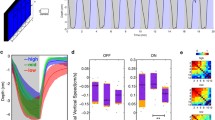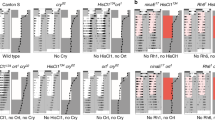Summary
The circadian locomotor activity rhythms of 7 species of lizards can readily be entrained (synchronized) toLD12: 12 (30–50 lux: 0) fluorescent light cycles after complete surgical removal of both eyes. Removal of the parietal eye and pineal organ does not prevent entrainment of blinded lizards. Appropriate control experiments established that lightper se, and not low amplitude temperature cycles or other obvious environmental variables, was the entraining stimulus for blinded lizards. In some cases, blocking the penetration of light to the brains of blinded lizards caused them to free-run (express their endogenous circadian rhythm) in the presence of a dim green light cycle, to which they had previously entrained, suggesting that the brain is the site of the extraretinal photoreceptor(s) mediating entrainment. The extraretinal photoreceptor(s) is capable of intensity discrimination since changing the intensity of aLD 12: 12 fluorescent light cycle caused a change in the phase-relationship between the entrained activity rhythm and the light cycle in a blinded gekko. The lateral eyes are also involved in mediating entrainment since removal of the lateral eyes of thoseSceloporus olivaceus which previously entrained to a dim green light cycle [LD 12: 12 (0.05 lux: 0)] caused them to free-run. Also, blinding had noticeable effects on the entrained activity patterns of some species of lizards.
Similar content being viewed by others
References
Adler, K.: Extraoptic phase shifting of circadian locomotor rhythm in salamanders. Science164, 1290–1292 (1969).
Adler, K.: Pineal end organ: Role in extraoptic entrainment of circadian locomotor rhythm in frogs. In: Biochronometry, ed. M. Menaker. Washington, D.C.: National Academy of Sciences 1971.
Ariëns-Kappers, J.: Survey of the innervation of the epiphysis cerebri and the accessory pineal organs in vertebrates. Progr. Brain Res.10, 87–153 (1965).
Ariëns-Kappers, J.: The sensory innervation of the pineal organ in the lizard,Lacerta viridis, with remarks on its position in the trend of pineal phylogenetic structural and functional evolution. Z. Zellforsch.81, 581–618 (1967).
Aschoff, J.: Response curves in circadian periodicity. In: Circadian clocks, ed. J. Aschoff. Amsterdam: North-Holland Pub. Co. 1965.
Bagnara, J. T., Hadley, M. E.: Endocrinology of the amphibian pineal. Amer. Zoologist10, 201–216 (1970).
Benoit, J.: The role of the eye and of the hypothalamus in the photostimulation of gonads in the duck. Ann. N.Y. Acad. Sci.117, 204–217 (1964).
Binkley, S., Kluth, E., Menaker, M.: Pineal function in sparrows: Circadian rhythms and body temperature. Science174, 311–314 (1971).
Binkley, S., Kluth, E., Menaker, M.: Pineal and locomotor activity. J. comp. Physiol.77, 163–169 (1972).
Browman, L. G.: The effect of bilateral optic enucleation upon the activity rhythms of the albino rat. J. comp. Psychol.36, 33–46 (1943).
Bruss, R. T., Jacobson, E., Halberg, F., Zander, H. A., Bittner, J. J.: Effects of lighting regimen and blinding upon gross motor activity of mice. Fed. Proc.17, 21 (1958).
Camp, C. L.: Classification of the lizards. Bull. Amer. Mus. Nat. Hist.48, 289–481 (1923).
Conant, R.: A field guide to reptiles and amphibians. Boston: Houghton Mifflin Co. 1958.
Dodt, E., Scherer, E.: The electroretinogram of the third eye. In: Advances in electrophysiology and -pathology of the visual system. 6th ISCERG Symposium. Leipzig: VEB G. Thieme 1968.
Eakin, R. M., Stebbins, R. C.: Parietal eye nerve in the fence lizard. Science130, 1573–1574 (1959).
Eakin, R. M., Westfall, J. A.: Further observations on the fine structure of the parietal eye of lizards. J. biophys. biochem. Cytol.8, 483–499 (1960).
Enright, J. T.: Synchronization and ranges of entrainment. In: Crcadian clocks (ed. J. Aschoff). Amsterdam: North-Holland Publ. Co. 1965.
Erikson, L. O.: Tagesperiodik geblendeter Bachsaiblinge. Naturwissenschaften59, 219–220 (1972).
Gaston, S., Menaker, M.: Pineal function: The biological clock in the sparrow? Science160, 1125–1127 (1968).
Gaston, S.: The influence of the pineal organ on the circadian activity rhythm in birds. In: Biochronometry (ed. M. Menaker). Washington, D.C.: National Academy of Sciences 1971.
Glaser, R. Increase in locomotor activity following shielding of the parietal eye in night lizards. Science128, 1577–1578 (1958).
Halberg, P., Visscher, M. B., Bittner, J. J.: Relation of visual factors to eosinophil rhythm in mice. Amer. J. Physiol.179, 229–235 (1954).
Hamasaki, D. I.: Spectral sensitivity of the parietal eye of the green iguana. Vision Res.9, 515–523 (1969).
Hamasaki, D. I., Dodt, E.: Light sensitivity of the lizard'sepiphysis cerebri. Pflügers Arch.313, 19–29 (1969).
Heckrotte, C.: The effect of environmental factors on the locomotor activity of the plains garter snake. Anim. Behav.10, 193–207 (1962).
Hoffmann, K.: Synchronisation der circadianen Aktivitätsperiodik von Eidechsen durch Temperaturcyclen verschiedener Amplitude. Z. vergl. Physiol.58, 225–228 (1968).
Hoffmann, K.: Zur Synchronisation biologischer Rhythmen. Verh. d. Dtsch. Zool. Ges. 1970: 266–273.
Homma, K., Sakakibara, Y.: Encephalic photoreceptors and their significance in photoperiodic control of sexual activity in Japanese quail. In: Biochronometry (ed. M. Menaker). Washington, D.C.: National Academy of Sciences 1971.
Hunt, J. M., Schlosberg, H.: The influence of illumination upon general activity in normal, blinded, and castrated male white rats. J. comp. Psychol.28, 285–298 (1939).
Kincl, F. A., Chang, C. C., Zbuzkova, V.: Observations on the influence of changing photoperiod on spontaneous wheel-running activity of neonatally pinealectomized rats. Endocrinology87, 38–42 (1970).
Kleinholz, L. H.: Studies in reptilian colour changes II. The pituitary and adrenal glands in the regulation of the melanophores ofAnolis carolinensis. J. exp. Biol.15, 474–491 (1938).
LaPointe, J. L.: Investigations of the function of the parietal eye in relation to locomotor activity cycles in the lizard,Xantusia vigilis. Ph. D. Thesis, Univ. of Calif., Berkeley 1966.
Lauber, J. K., Body, J. E., Axelrod, J.: Enzymatic synthesis of melatonin in avian pineal body: Extraretinal response to light. Science161, 489–490 (1968).
Machado, C. R. S., Machado, A. B. M., Wragg, L. E.: Circadian serotonin rhythm control: Sympathetic and nonsympathetic pathways in rat pineals of different ages. Endocrinology85, 846–848 (1969b).
Machado, C. R. S., Wragg, L. E., Machado, A. B. M.: Circadian rhythm of serotonin in the pineal body of immunosympathectomized immature rats. Science164, 442–443 (1969a).
McMillan, J. P.: Pinealectomy abolishes the circadian rhythm of migratory restlessness. J. comp. Physiol.79, 105–112 (1972).
Menaker, M.: Extraretinal light perception in the sparrow, I. Entrainment of the biological clock. Proc. nat. Acad. Sci. (Wash.)59, 414–421 (1968a).
Menaker, M.: Light perception by extraretinal receptors in the brain of the sparrow. Proc. Amer. Psychol. Ass. 76th, 299–300 (1968b).
Menaker, M., Roberts, R., Elliott, J., Underwood, H.: Extraretmal light perception in the sparrow, III: The eyes do not participate in photoperiodic photoreception. Proc. nat. Acad. Sci. (Wash.)67, 320–325 (1970).
Oksche, A., Kirschstein, H.: Unterschiedlicher elektronenmikroskopischer Feinbau der Sinneszellen im Parietalauge und im Pinealorgan (Epiphysis cerebri) von Lacertilia. Z. Zellforsch.87, 159–192 (1968).
Parker, G. H.: Animal colour changes and their neurohumours. Cambridge, England: Cambridge Univ. Press 1948.
Pearse, A. S.: The reactions of amphibians to light. Proc. Amer. Acad. Arts Sci.45, 161–208 (1910).
Pittendrigh, C. S.: Circadian rhythms and the circadian organization of living systems. Cold Spr. Harb. Symp. quant. Biol.25, 159–184 (1960).
Pittendrigh, C. S.: On the mechanism of the entrainment of a circadian rhythm by light cycles. In: Circadian clocks (ed. J. Aschoff). Amsterdam: North-Holland Publ. Co. 1965.
Quay, W. B.: Individuation and lack of pineal effect in the rat's circadian locomotor rhythm. Physiol. Behav.3, 109–118 (1968).
Quay, W. B.: Physiological significance of the pineal during adaptation to shifts in photoperiod. Physiol. Behav.5, 353–360 (1970a).
Quay, W. B.: Precocious entrainment and associated characteristics of activity patterns following pinealectomy and reversal of photoperiod. Physiol. Behav.5, 1281–1290 (1970b).
Quay, W. B.: Dissimilar functional effects of pineal stalk and cerebral meningeal interruptions on phase shifts of circadian activity rhythms. Physiol. Behav.7, 557–567 (1971).
Quay, W. B.: Pineal homeostatic regulation of shifts in the circadian activity rhythm during maturation and aging. Trans. N.Y. Acad. Sci.34, 239–254 (1972).
Reed, B. L.: The control of circadian pigment changes in the pencil fish: A proposed role for melatonin. Life Sci.7, 961–973 (1968).
Richter, C. P.: Biological clocks in medicine and psychiatry. Springfield, III.: C. C. Thomas 1965.
Richter, C. P.: Inherent twenty-four hour and lunar clocks of a primate—the squirrel monkey. Communications in Behavioral Biology1, 305–332 (1968).
Scharrer, E.: Die Lichtempfindlichkeit blinder Elritzen (Untersuchungen über das Zwischenhirn der Fische I). Z. vergl. Physiol.7, 1–38 (1928).
Snyder, S. H., Zweig, M., Axelrod, J., Fischer, J. E.: Control of the circadian rhythm in serotonin content of the rat pineal gland. Proc. nat. Acad. Sci. (Wash.)53, 301–305 (1965).
Stebbins, R. C., Eakin, R. M.: The role of the “third eye” in reptilian behavior. Amer. Mus. Novitates1870, 1–40 (1958).
Stebbins, R. C.: Effects of pinealectomy in the western fence lizardSceloporus occidentalis. Copeia1960, 276–283 (1960).
Stebbins, R. C.: Activity changes in the striped plateau lizard with evidence on influence of the parietal eye. Copeia1963, 681–691 (1963).
Stebbins, R. C.: A field guide to western reptiles and amphibians. Boston: Houghton Mifflin Co. 1966.
Stebbins, R. C., Wilhoft, D. C.: Influence of the parietal eye on activity in lizards. In: The Galápagos: Proceedings of the symposia of the Galápagos international scientific project (ed. R. I. Bowman). Univ. of Calif. Press 1966.
Stebbins, R. C.: The effect of parietalectomy on testicular activity and exposure to light in the desert night lizard (Xantusia vigilis). Copeia1970, 261–270 (1970).
Steyn, W.: Electron microscopic observations on the epiphysial sensory cells in lizards and the pineal sensory cell problem. Z. Zellforsch.51, 735–747 (1960).
Taylor, D. H., Ferguson, D. E.: Extraoptic celestial orientation in the southern cricket frogAcris gryllus. Science168, 390–392 (1970).
Underwood, H.: Extraretinal light perception in lizards: Entrainment of the biological clock controlling locomotor activity. Ph. D. Thesis. Univ. of Texas, Austin 1972.
Underwood, H., Menaker, M.: Extraretinal light perception: Entrainment of the biological clock controlling lizard locomotor activity. Science170, 190–193 (1970).
Wetterberg, L., Geller, E., Yuwiler, A.: Harderian gland: An extraretinal photoreceptor influencing the pineal gland in neonatal rats? Science167, 884–885 (1970a).
Wetterberg, L., Yuwiler, A., Ulrich, R., Geller, E., Wallace, R.: Harderian gland: Influence on pineal hydroxyindole-o-methyltransferase activity in neonatal rats. Science170, 194–196 (1970b).
Wever, R.: A mathematical model for circadian rhythms. In: Circadian clocks (ed. J. Aschoff). Amsterdam: North-Holland Publ. Co. 1965.
Wurtman, R. J., Axelrod, J., Kelly, D. E.: The pineal. New York: Academic Press 1968.
Zweig, M., Snyder, S. H., Axelrod, J.: Evidence for a nonretinal pathway of light to the pineal gland of newborn rats. Proc. nat. Acad. Sci. (Wash.)56, 515–520 (1966).
Author information
Authors and Affiliations
Additional information
I thank Michael Menaker, Jeffrey Elliott, Sue Binkley, Joseph Silver, Ed Kluth, George Wyche, Bruee Rouse, Nancy Leshikar, Lili Mostafavi, Janet Alvis, Celeste Cromack, A. L. Mackey and Jean Rogers for their suggestions and technical assistance. Support for this work was provided by NIH grant HD-03803-02 (to M. Menaker); NSP grant GB-8138 (to M. Menaker); NSF traineeship GZ-1336 (to H. Underwood); and MH traineeship 5T01GM00836-09 (to H. Underwood).
Rights and permissions
About this article
Cite this article
Underwood, H. Retinal and extraretinal photoreceptors mediate entrainment of the circadian locomotor rhythm in lizards. J. Comp. Physiol. 83, 187–222 (1973). https://doi.org/10.1007/BF00696895
Received:
Issue Date:
DOI: https://doi.org/10.1007/BF00696895




